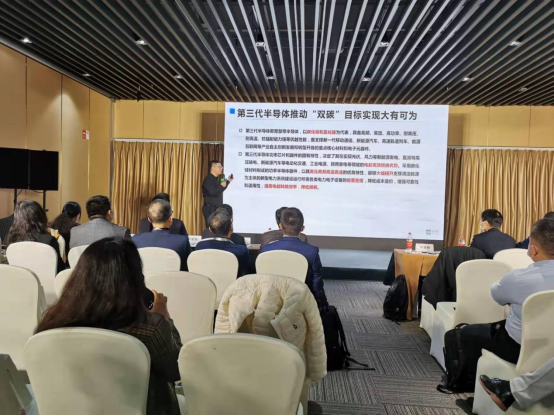
Editing by Xin Lanhua
As China joins the world in seeking carbon neutrality goals, the investment in third-generation semiconductors, which is in its early development stage, will carry on added implications and play a valuable role in reducing energy consumption and meeting the carbon goals. Chen Yuenan, JW Insights senior analyst, made this viewpoint in his keynote speech at the Beijing International Seminar on Microelectronics & IC WORLD Conference held in late October.
This article is a summary of his speech on the third-generation semiconductor industry and its investment opportunities.

China has set a goal for CO2 emissions peaking before 2030 and achieving carbon neutrality before 2060. This means China must strive to achieve a significant reduction in CO2 emission gradually to zero by 2060.
The 3rd generation semiconductor, spearheaded by SiC (silicon carbide) and GaN (gallium nitride), has advantages in high frequency, efficiency, power, pressure resistance, temperature resistance, and radiation resistance. These features enable high power conversion in new energy power generation, DC UHV power transmission, new energy vehicles that employ photovoltaic and wind technologies.
China’s third-generation semiconductor industry is comparatively at an early stage. Some companies have emerged to be strong players. They include TankeBlue Semiconductor (天科合达), SICC(山东天岳), TYSiC (东莞天域), Global Power Technology (泰科天润), Shenzhen Basic Semiconductor(深圳基本半导体).
The recent geopolitical changes have accelerated China’s drive for a more self-reliant supply chain. More Chinese companies have thus obtained opportunities for trial and win, enabling more domestic products into the supply chain.
According to statistics from Yole and Omdia, the SiC power electronics market reached approximately US$703 million by the end of 2020. This number may exceed US$3 billion by 2025, during which new energy vehicles and consumer electronics are the main drivers. Yole predicts that the SiC automotive market will grow at a compound annual growth rate of 38% to more than $1.5 billion by 2025.
SiC device/module is mainly used in the power electronics market, including rail transit, PV inverter, new energy vehicles, and consumer electronics.
The SiC industry chain with its big potential and bright future includes upstream (the growth of substrate and epitaxy), mid-stream (design and manufacture), and downstream (application).
The downstream applications are still at the R&D stage. A boom is expected to emerge in 2030.
Tesla's Shanghai plant and BYD have adopted SiC MOSFET chips as the core power devices in their motor controller inverters. Other automobile companies like Toyota, Volkswagen, Honda, BMW, Audi have also incorporated SiC power devices in their plan. SiC power devices will become the mainstream technical solution for motor drive systems in new energy vehicles, with tremendous opportunities in the next three to five years.
SiC is also suitable in 5G base station power supplies, data centers, photovoltaics, and wind power fields.

The GaN sector is similar to that of SiC. Its main applications are in power electronics, radiofrequency, and optoelectronics.
Yole predicts that the GaN power electronic device market will exceed $1.5 billion by 2025. There is already an explosive USB power delivery quick charging market. Statistics from CASA Research show that in 2020, the domestic market reached RMB 150 million ($23.5 million), and the global market exceeded RMB 300 million ($46.9 million). By 2025, it will exceed RMB 4 billion ($625.9 million) with a 97% compound annual growth rate, and the global figures will reach more than RMB 8 billion ($1.25 billion), a 90% growth.
Microwave RF is another major target market. The national defense and 5G base station are the important driving forces for the GaN RF device market. The market of China's 5G macro station GaN PA (Power Amplifier) will reach RMB 7.3 billion($1.14 billion) in 2020, and close to RMB 10 billion ($1.56 billion) in 2022 with a 17.5% compound growth rate. The 5G will bring about more than RMB 10 billion ($1.56 billion) demands for GaN PA.
Despite its vast potential, the GaN application market is limited to quick charging and some RF fields; the invested supply outweighs demand, with the need to promote more applications.
Many local governments have joined the push by issuing more favorable policies and encouraging new applications.
But there are signs of overheating in the capital market for the 3rd generation semiconductor.
According to JW Insights' statistics, the investment in GaN and SiC reached RMB 14.4 billion ($2.25 billion) and RMB 55.5 billion ($8.68 billion) in 2020. Investors need to stay coolheaded, learn from the experience in traditional semiconductor investment, and avoid aborted projects.
Related companies should check the industrial distribution and market demands before expanding production and avoid redundant constructions and low-level expansion.
Mergers and restructuring should also be considered to integrate innovative resources, achieve development scale, and enhance competitiveness.
RELATED
-
Yole: the global power device market is expected to grow to $33.3 billion by 2028 with China taking a lead
10-31 14:47 -
ijiweiTalk Ep 309:A Roadmap for SiC Power Devices:Twisted but Prosperous
10-31 10:00 -
Chinese compound semiconductor supplier San’an moves closer to supplying its car chip joint venture with ST Microelectronics
10-26 15:09
READ MOST

No Data Yet~







